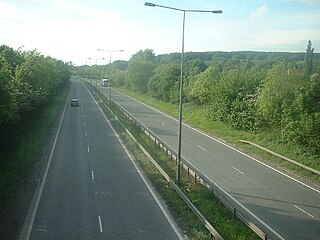
Wile E. Coyote and the Road Runner are a duo of cartoon characters from the Looney Tunes and Merrie Melodies series of animated cartoons, first appearing in 1949 in the theatrical short Fast and Furry-ous. In each film, the cunning, devious and constantly hungry coyote repeatedly attempts to catch and eat the roadrunner, but is humorously unsuccessful. Instead of using animal instinct, the coyote deploys absurdly complex contraptions to try to catch his prey. They comically backfire, with the coyote invariably getting injured in slapstick fashion. Many of the items for these contrivances are mail-ordered from a variety of companies implied to be part of the Acme Corporation. TV Guide included Wile E. Coyote in its 2013 list of "The 60 Nastiest Villains of All Time".

A milestone is a numbered marker placed on a route such as a road, railway line, canal or boundary. They can indicate the distance to towns, cities, and other places or landmarks like mileage signs; or they can give their position on the route relative to some datum location. On roads they are typically located at the side or in a median or central reservation. They are alternatively known as mile markers, mileposts or mile posts. A "kilometric point" is a term used in metricated areas, where distances are commonly measured in kilometres instead of miles. "Distance marker" is a generic unit-agnostic term.

Numbered highways in Canada are split by province, and a majority are maintained by their province or territory transportation department. With few exceptions, all highways in Canada are numbered. Nonetheless, every province has a number of highways that are better known locally by their name rather than their number. Some highways have additional letters added to their number: A is typically an alternate route, B is typically a business route, and other letters are used for bypass (truck) routes, connector routes, scenic routes, and spur routes. The territory of Nunavut has no highways.

A rush hour or peak hour is a part of the day during which traffic congestion on roads and crowding on public transport is at its highest. Normally, this happens twice every weekday: once in the morning and once in the afternoon or evening, the times during which most people commute. The term is often used for a period of peak congestion that may last for more than one hour.

A dual carriageway (BrE) or a divided highway (AmE) is a class of highway with carriageways for traffic travelling in opposite directions separated by a central reservation (BrE) or median (AmE). Roads with two or more carriageways which are designed to higher standards with controlled access are generally classed as motorways, freeways, etc., rather than dual carriageways.

A diamond interchange is a common type of road junction, used where a controlled-access highway crosses a minor road.
A post town is a required part of all postal addresses in the United Kingdom and Ireland, and a basic unit of the postal delivery system. Including the correct post town in the address increases the chance of a letter or parcel being delivered on time. Post towns in general originated as the location of delivery offices. As of 2004, their main function is to distinguish between localities or street names in addresses not including a postcode.
A routenumber, designation or abbreviation is an identifying numeric designation assigned by a highway authority to a particular stretch of roadway to distinguish it from other routes and, in many cases, also to indicate its classification, general geographical location and/or orientation. The numbers chosen may be used solely for internal administrative purposes; however, in most cases they are also displayed on roadside signage and indicated on maps.

E 11 is a highway in the United Arab Emirates (UAE). The longest road in the Emirates, it stretches from the Al Batha border crossing at the Saudi Arabia–UAE border in al-Silah in the al-Dhafra region of the Emirate of Abu Dhabi and ends at the Oman–UAE border crossing of al-Darah in al-Jeer, Emirate of Ras al-Khaimah, running roughly parallel to UAE's coastline along the Persian Gulf. The road forms the main artery in some emirates' main cities, where it assumes various alternate names —Sheikh Maktoum Bin Rashid Road and Sheikh Khalifa bin Zayed Road in Abu Dhabi, Sheikh Zayed Road in Dubai, Al Ittihad Road in Sharjah Emirate and Ajman Emirate, and Sheikh Muhammad bin Salem Road in Ras al-Khaimah.

The National Football League (NFL) playoffs is the annual single-elimination tournament held to determine the league champion. The four-round tournament is held after the league's regular season. Since the 2020 season, seven teams from each of the league's two conferences qualify for the playoffs based on regular season winning percentage, with a tie-breaking procedure if required. The top team in each conference receives a first-round bye, automatically advancing to the next round. The tournament culminates in the Super Bowl, the league's championship game, competed between teams from each conference. Among the four major professional sports leagues in the United States, the NFL postseason is the only one to use a single-elimination tournament in all of its rounds.

A county highway is a road in the United States and in the Canadian province of Ontario that is designated and/or maintained by the county highway department. Route numbering can be determined by each county alone, by mutual agreement among counties, or by a statewide pattern.

Road bicycle racing is the cycle sport discipline of road cycling, held primarily on paved roads. Road racing is the most popular professional form of bicycle racing, in terms of numbers of competitors, events and spectators. The two most common competition formats are mass start events, where riders start simultaneously and race to a set finish point; and time trials, where individual riders or teams race a course alone against the clock. Stage races or "tours" take multiple days, and consist of several mass-start or time-trial stages ridden consecutively.

In the field of road transport, an interchange or a grade-separated junction is a road junction that uses grade separations to allow for the movement of traffic between two or more roadways or highways, using a system of interconnecting roadways to permit traffic on at least one of the routes to pass through the junction without interruption from crossing traffic streams. It differs from a standard intersection, where roads cross at grade. Interchanges are almost always used when at least one road is a controlled-access highway (freeway) or a limited-access highway (expressway), though they are sometimes used at junctions between surface streets.

A controlled-access highway is a type of highway that has been designed for high-speed vehicular traffic, with all traffic flow—ingress and egress—regulated. Common English terms are freeway, motorway, and expressway. Other similar terms include throughway or thruway and parkway. Some of these may be limited-access highways, although this term can also refer to a class of highways with somewhat less isolation from other traffic.
The 2004–05 NBA season was the 59th season of the National Basketball Association (NBA). It began on November 2, 2004, and ended on June 23, 2005. The season ended with the San Antonio Spurs defeating the defending-champion Detroit Pistons, 4–3, in the NBA Finals.

The Pakistan Defense Officers Housing Authority (PDOHA), Karachi, formerly Pakistan Defense Officers Cooperative Housing Society, is a residential neighbourhood or a housing society located within Clifton Cantonment of Karachi. The total population of Clifton Cantonment, including Defense Housing Authority, is 305,938, per 2017 Census of Pakistan. DHA has a majority population of Muhajirs.

A junction is where two or more roads meet.

A Parish Assembly in Jersey is the decision-making body of local government, comprising ratepayers and electors of the parish.
Highways are split into at least four different types of systems in the United States: Interstate Highways, U.S. Highways, state highways, and county highways. Highways are generally organized by a route number or letter. These designations are generally displayed along the route by means of a highway shield. Each system has its own unique shield design that will allow quick identification to which system the route belongs.
Hamidabad is a village in Fazl Rural District, in the Central District of Nishapur County, Razavi Khorasan Province, Iran. At the 2006 census, its population was 711, in 201 families.

















